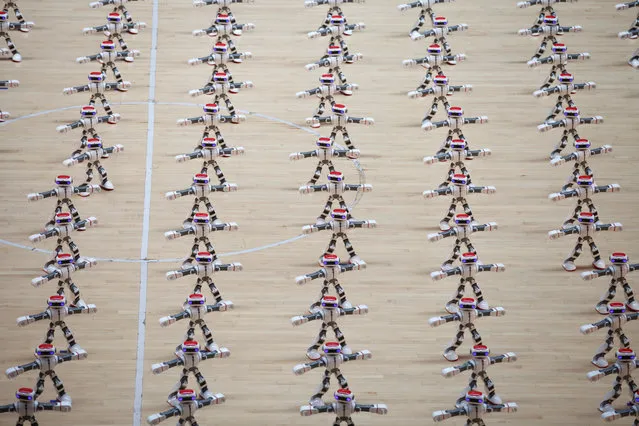
Robots perform dancing during a robot contest in Dezhou, Shandong province, China August 21, 2017. (Photo by Reuters/China Stringer Network)
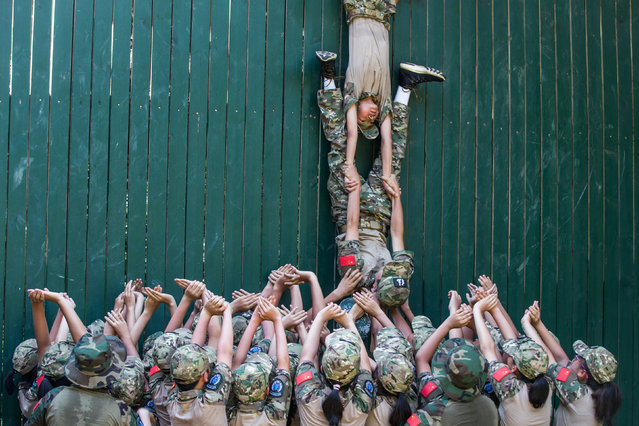
Hanging around: middle-school students take part in a military training in Zhejiang province, Hangzhou, China on August 20, 2017. (Photo by Reuters/China Stringer Network)
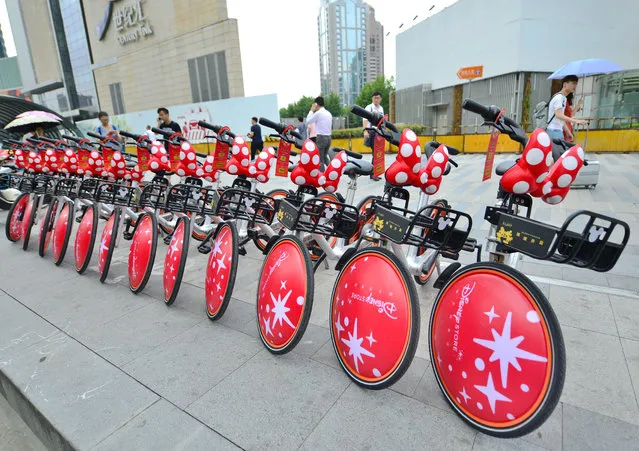
Minnie Mouse-themed bicycles line a road in the city as part of a Disney/Mobike bike-sharing venture in Shanghai, China on Agust 17, 2017. (Photo by Imaginechina/Rex Features/Shutterstock)
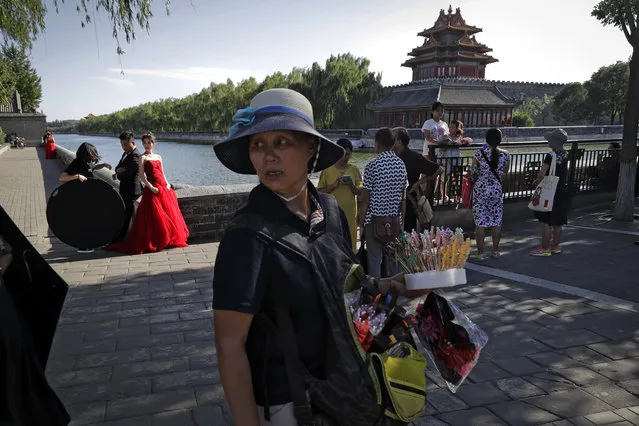
A vendor sells souvenirs as tourists gather near a bride and groom posing for their pre-wedding photos in front of the Turret of the Forbidden City in Beijing, Thursday, August 24, 2017. The Forbidden City, once the isolated palace of China's Ming and Qing Dynasty emperors and now turn into a major tourist attraction, located in the centre of capital city. (Photo by Andy Wong/AP Photo)

Villagers put tomatoes under the sun, creating a blanket of deep red, to dry them in Hejing county in the Mongolian autonomous prefecture of Bayingolin, China on August 20, 2017. (Photo by Xinhua News Agency/Rex Features/Shutterstock)
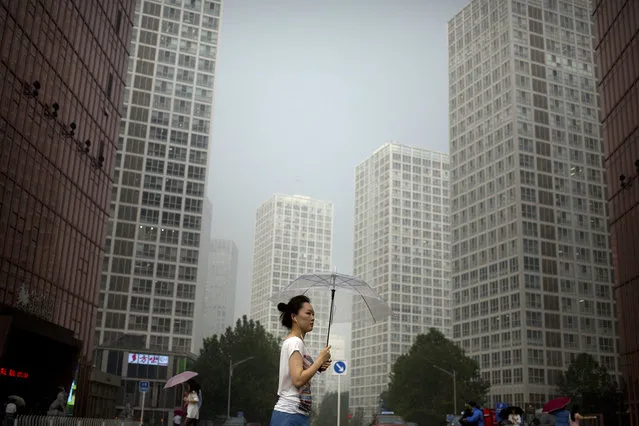
A woman carries an umbrella as she walks through the central business district of Beijing during a rain shower, Friday, August 11, 2017. Although China's capital is in a semi-dry climate, it receives much of its annual precipitation during the summer months. (Photo by Mark Schiefelbein/AP Photo)
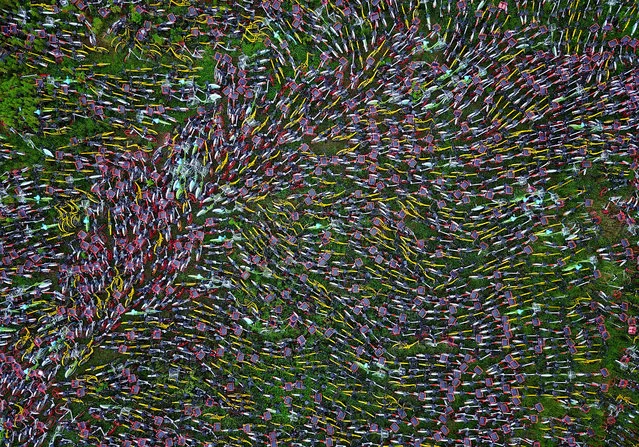
An aerial view of the rental bikes detained by the local urban administration authority of Luyang district on August 16, 2017 in Hefei, China. Tens of thousands of rental bikes parked at spots causing troubles to pedestrians and traffic in streets have been removed away by government authorities to the graveyards of the bikes while bike companies struggle to regulate the parking behavior of their users. (Photo by Feature China/Barcroft Images)
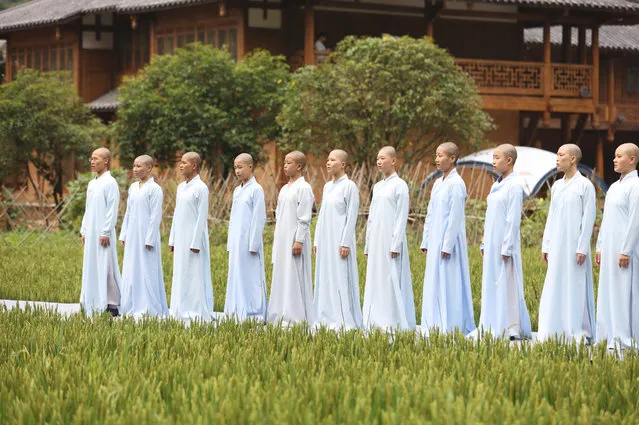
China's first monks chorus, “Dawn” chorus from Tiantai Temple Conservatory of Buddhist Music, perform on the roof of a music hall at the 2017 Huanglong Music Festival and International Chorus Week on August 21, 2017 in Zhangjiajie, Hunan Province of China. 112 teams will compete in the 2017 Huanglong Music Festival and International Chorus Week held in Zhangjiajie. (Photo by VCG/VCG via Getty Images)
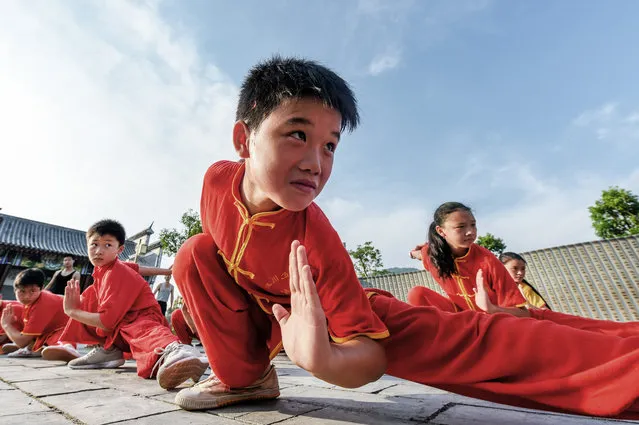
Children from a Shaolin martial art institute practise kung fu at a village in Suichuan County on August 13, 2017 in Ji'an, Jiangxi Province of China. (Photo by VCG/VCG via Getty Images)
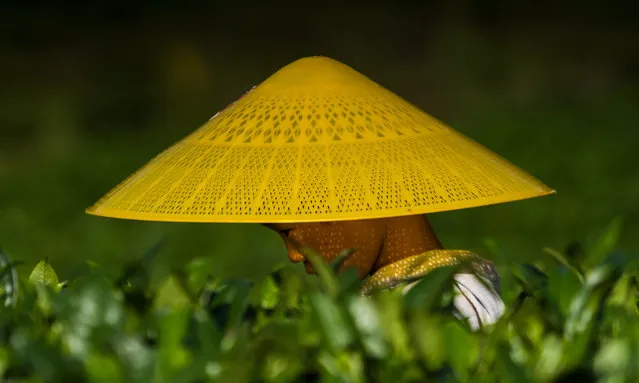
A woman works in the field in a valley between Zunyi and Maotai town, Guizhou province, China, 15 August 2017. (issued 21 August) Moutai is a brand of baijiu, a distilled Chinese liquor (spirit), made in the town of Maotai in China's Guizhou province. Produced by the state-owned Kweichow Moutai Company, the beverage is distilled from fermented sorghum and now comes in several different varieties. Maotai was produced at several local distilleries. During the Chinese Civil War, People's Liberation Army forces camped at Maotai and partook of the local liquor. Following the Communist victory in the war, the government consolidated the local distilleries into one state-owned company, Kweichow Moutai. It became a popular drink at state functions, one of the country's most popular spirits as well as symbol of corruption in China in previous years. The price of Moutai is soaring. Real market price for a bottle of 2014 Moutai Feitian can reach well above 2,000 yuan (255 EURO), almost double that of a year ago. A bottle produced in 2003 is priced at above 4,000 yuan (510 EURO). Moutai’s Shanghai-listed shares closed in May 2017 at 454 yuan (57.90 EURO), the highest level since the company’s 2001 listing, and up more than 300 per cent from its early 2014 level, when the share price was just above 100 yuan (12.75 EURO). Blessed with a stock that is trading at 30 times earnings per share, the company has unseated Johnnie Walker producer Diageo as the world’s most valuable liquor concern. While Moutai is China’s national liquor – former premier Zhou Enlai used it to entertain Richard Nixon in Beijing when the former US president visited China, Deng Xiaoping relied on it to repeatedly toast Henry Kissinger at the Waldorf-Astoria hotel in New York, and President Xi Jinping brought bottles of it to exchange goodwill with Ma Ying-jeou, the former president of Taiwan, in Singapore – the drink has also won a name as a symbol for lavish government spending. (Photo by Aleksandar Plavevski/EPA)
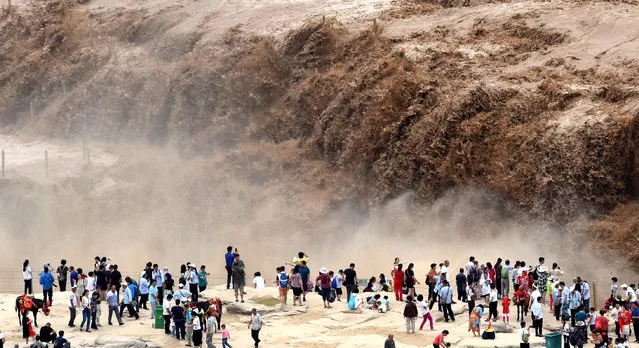
People visit the Hukou Waterfall on the Yellow River on the border area between Jixian County of north China's Shanxi and Yichuan County of northwest China's Shaanxi provinces, August 24, 2017. Due to heavy rainfall at the upper reaches, the water volume of Hukou Waterfall surged. (Photo by Lyu Guiming/Xinhua/Barcroft Images)
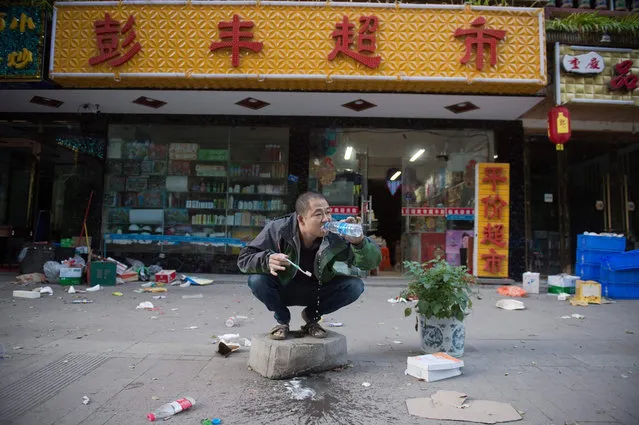
A resident brushes his teeth outside his shop after an earthquake in Zhangzha in southwest China' s Sichuan province on August 10, 2017. The 6.5- magnitude earthquake struck Sichuan province late on August 8, tearing cracks in mountain highways, triggering landslides, damaging buildings and sending panicked residents and tourists fleeing into the open. (Photo by Nicolas Asfouri/AFP Photo)
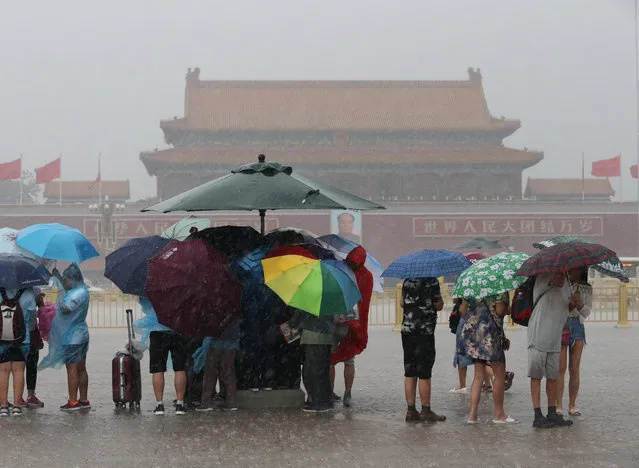
Tourists hold umbrellas as they visit Tiananmen Square during a rainstorm in Beijing, China August 12, 2017. (Photo by Reuters/China Stringer Network)
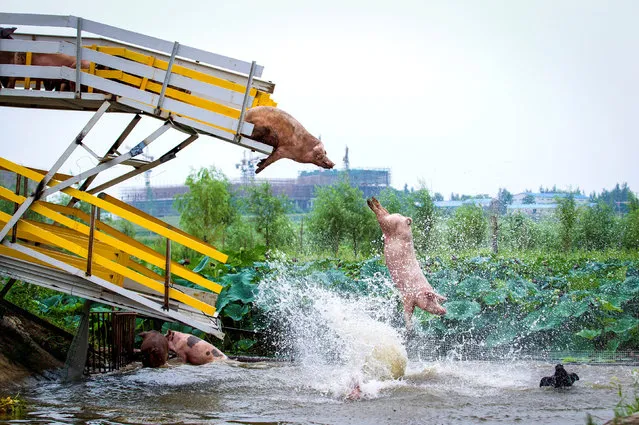
Pigs are herded off a platform into water by breeders during a daily exercise at a pig farm in Shenyang, Liaoning province, China August 14, 2017. (Photo by Reuters/China Stringer Network)
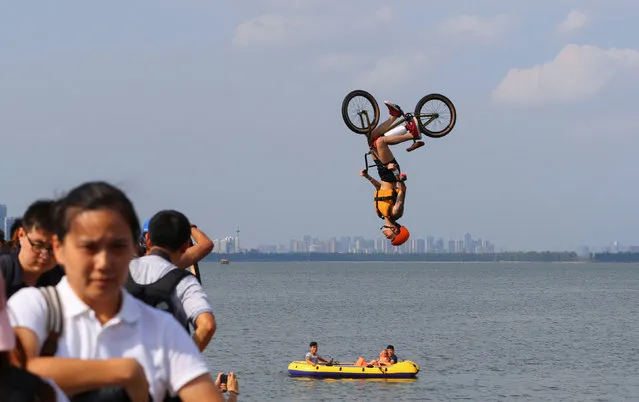
A man performs a BMX bicycle trick as he jumps into East Lake in Wuhan, Hubei Province, China August 19, 2017. (Photo by Reuters/China Stringer Network)
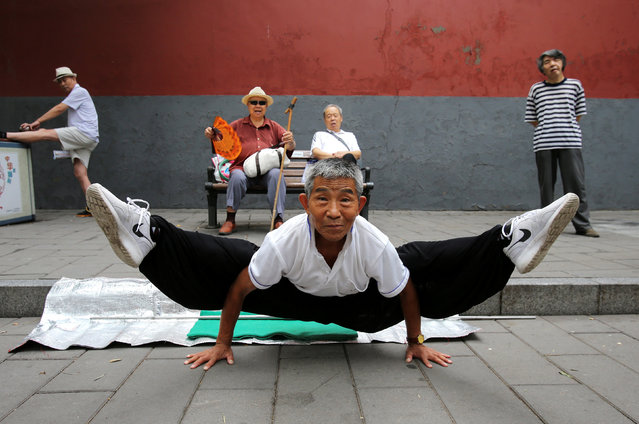
A man performs a split as he practices Kung Fu at Beihai Park in Beijing, China August 20, 2017. (Photo by Reuters/China Stringer Network)
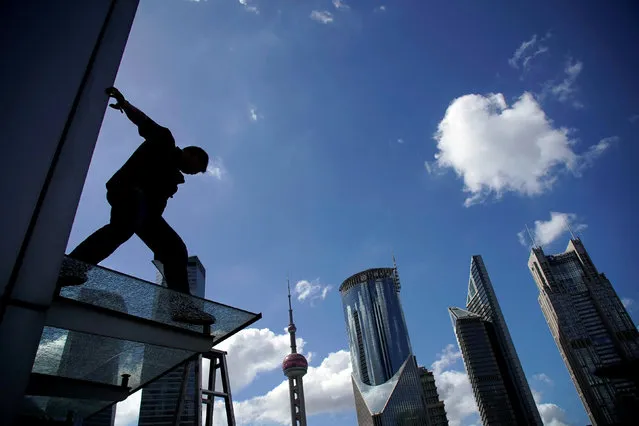
A laborer works on a glass roof in Shanghai, China August 22, 2017. (Photo by Aly Song/Reuters)
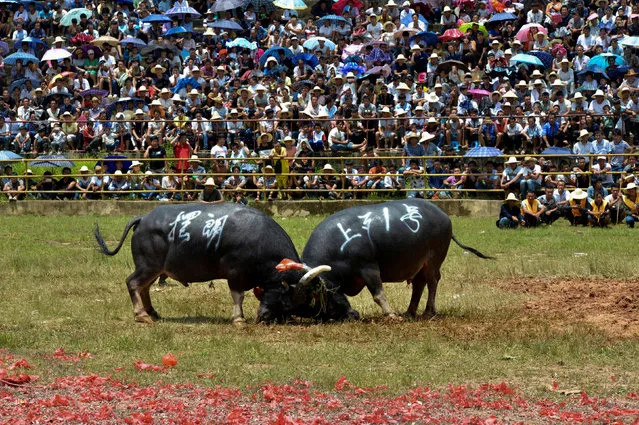
People watch a bull fight in Congjiang county, Guizhou province, China August 26, 2017. (Photo by Reuters/China Stringer Network)
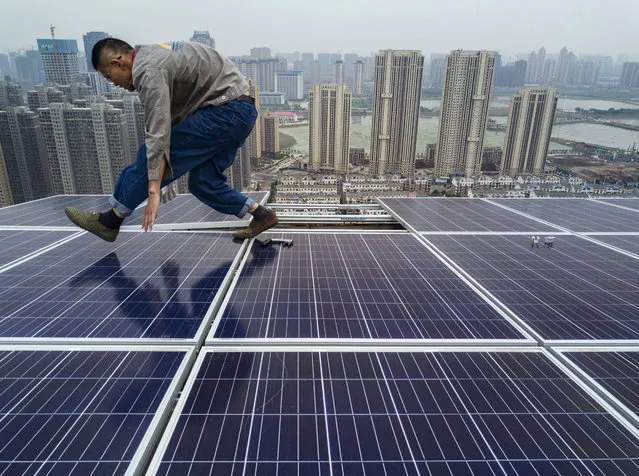
A Chinese worker from Wuhan Guangsheng Photovoltaic Company works on a solar panel project on the roof of a 47 story building in a new development on May 15, 2017 in Wuhan, China. China consumes more electricity than any other nation, but it is also the world's biggest producer of solar energy. Capacity in China hit 77 gigawatts in 2016 which helped a 50% jump in solar power growth worldwide. China is now home to two-thirds of the world's solar production, though capacity and consumption remain low relative to its population. Still, the country now buys half of the world's new solar panels which convert sunlight into energy, and are being installed on rooftops in cities and across sprawling fields in rural areas. Greenpeace estimates that by 2030, renewable energy could replace fossil fuels as China's primary source of power, a significant change in a country considered the world's biggest polluter. China's government has officially committed to development of renewable energies to ease the country's dependence on coal and other fossil fuels, though its strategic investments in the solar panel have created intense global competition. (Photo by Kevin Frayer/Getty Images)
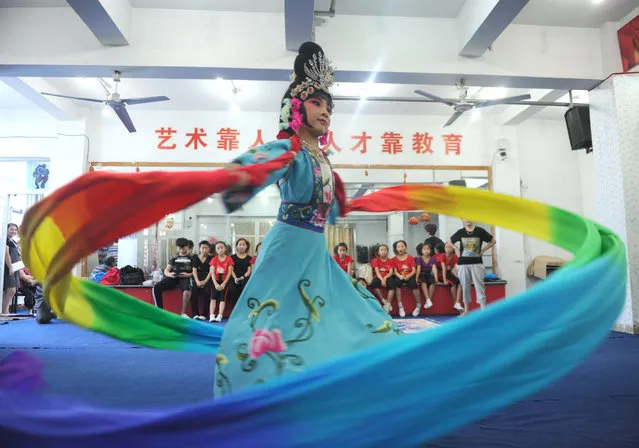
Zhao Zhiting, a 12-year-old girl, has been learning Peking Opera for six years in Huainan, east China's Anhui Province in Huainan, China on August 16, 2017. (Photo by SIPA Asia/Rex Features/Shutterstock)
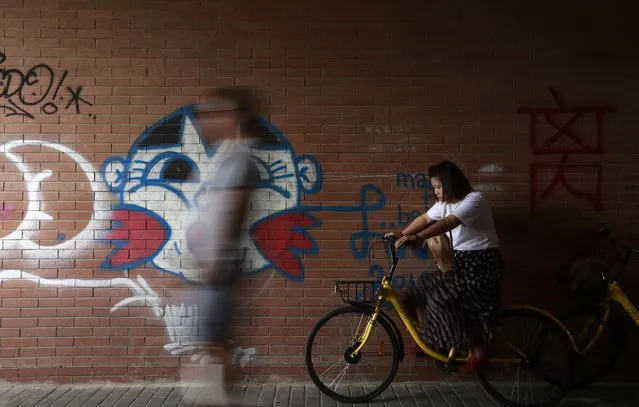
A visitor walks past graffiti art as a cyclist waits by at 798 Art district in Beijing, China, 26 August 2017. The Beijing 798 art district is made up of a complex of decommissioned military factory buildings, housing a variety of quirky art galleries and cafes popular with tourists and young people. (Photo by How Hwee Young/EPA/EFE)
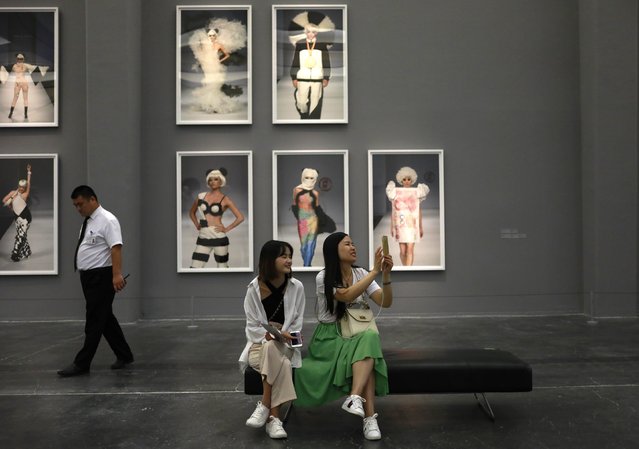
Visitors look at artworks by Chinese artist Zhao Bandi during the “Zhao Bandi: China Party” exhibition at Ullens Center for Contemporary Art (UCCA) in the 798 Art district in Beijing, China, 26 August 2017. The exhibition showcase nearly three decades of the artist's career showing more than a dozen of his works and projects from 1987 to the present including fashion design, video, film, performance, and painting. (Photo by How Hwee Young/EPA/EFE)
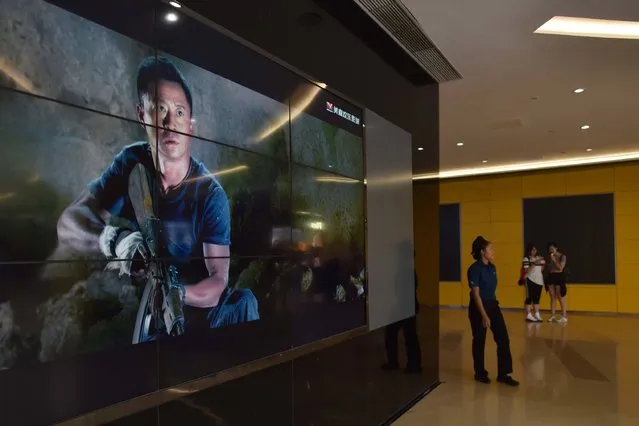
A woman walks past a video screen showing scenes from the movie “Wolf Warrior 2” outside a theater in Beijing on August 21, 2017. Fresh from shattering China's box-office record, patriotic blockbuster “Wolf Warriors 2” has claimed another slice of history by becoming the first non-Hollywood film to break into the top 100 all-time grossing movies worldwide. (Photo by Greg Baker/AFP Photo)
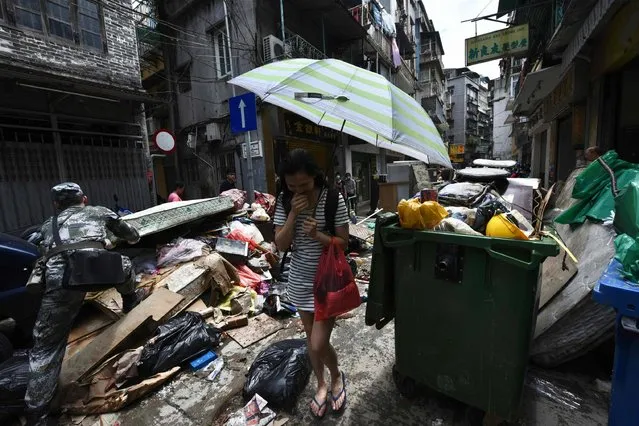
A resident holds her nose due to the smell of rotting debris and garbage as a Chinese People's Liberation Army soldier (L) based at a barracks in Macau helps clear debris from a street in Macau on August 25, 2017, two days after Typhoon Hato hit the territory. At least nine people are now known to have died in Macau when a huge typhoon swept through the gambling hub, plunging casinos into darkness and sparking destructive floods. (Photo by Anthony Wallace/AFP Photo)
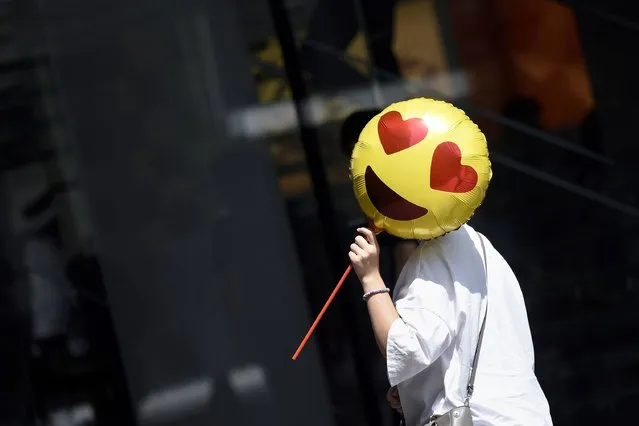
A woman holds a balloon as she walks past a store on Chinese Valentine's Day in Beijing on August 28, 2017. Qixi Festival, or Chinese Valentine's Day, which falls on the seventh day of the seventh lunar month, is a time when girls traditionally demonstrate their domestic skills and wish for a good husband. (Photo by Wang Zhao/AFP Photo)

A Chinese woman browses a smartphone on a sofa displaying a panda and bears at a shopping mall in Beijing, Monday, August 21, 2017. Some shopping malls and retailers in the capital city are organizing activities and decorations to attract shoppers as a chance to boost sales in the summer holidays. (Photo by Andy Wong/AP Photo)
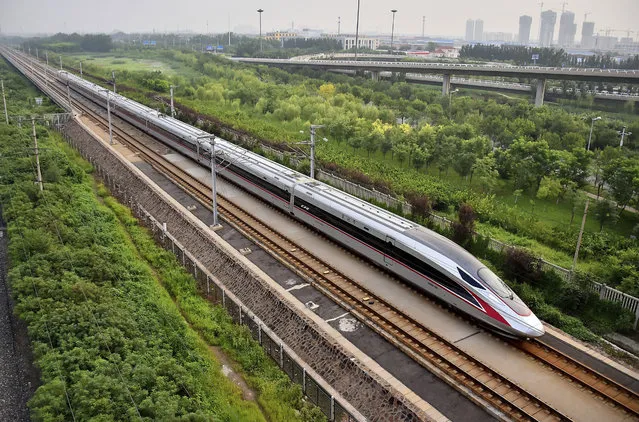
In this August 21, 2017 photo released by China's Xinhua News Agency, a Fuxing bullet train, China's latest high-speed train, arrives at a train station in northern China's Tianjin Municipality. China is relaunching the world's fastest bullet trains in September 2017, running at 350 kilometers (217 miles) per hour. China first ran trains at 350 kilometers per hour in August 2008, but cut speeds back to 250-300 kilometers per hour in 2011 following a two-train collision near the city of Wenzhou that killed 40 people and injured 191. (Photo by Yang Baosen/Xinhua via AP Photo)
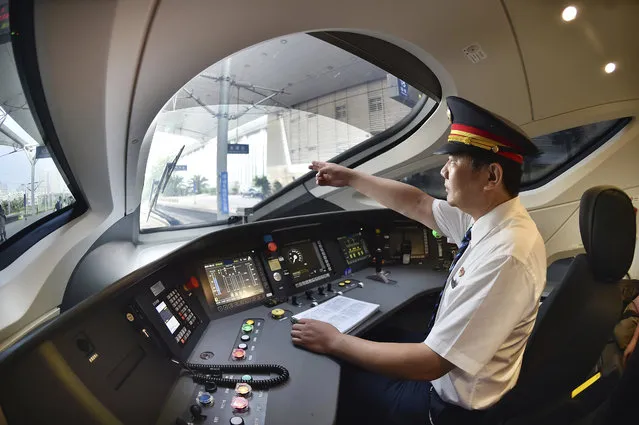
In this August 21, 2017 photo released by China's Xinhua News Agency, a train driver prepares to operate the Fuxing bullet train, China's latest high-speed train, to Beijing from northern China's Tianjin Municipality. (Photo by Yang Baosen/Xinhua via AP Photo)
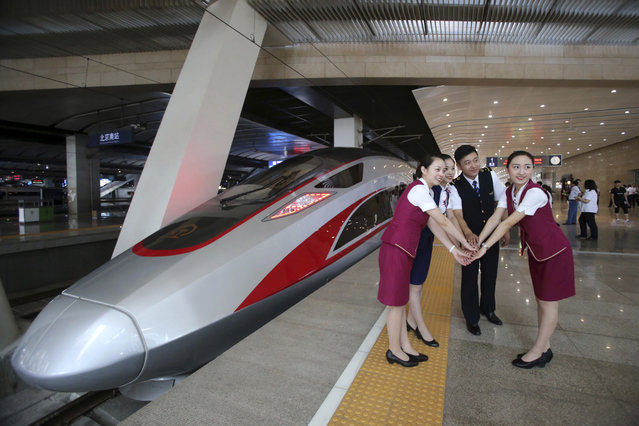
In this June 26, 2017 file photo, railway workers pose for photos with the Fuxing, China's latest high speed train capable of reaching 400kph (248mph) during its maiden service from Beijing. China is relaunching the world's fastest bullet trains in September 2017, running at 350 kilometers (217 miles) per hour. China first ran trains at 350 kilometers per hour in August 2008, but cut speeds back to 250-300 kilometer per hour in 2011 following a two-train collision near the city of Wenzhou that killed 40 people and injured 191. (Photo by Chinatopix via AP Photo)
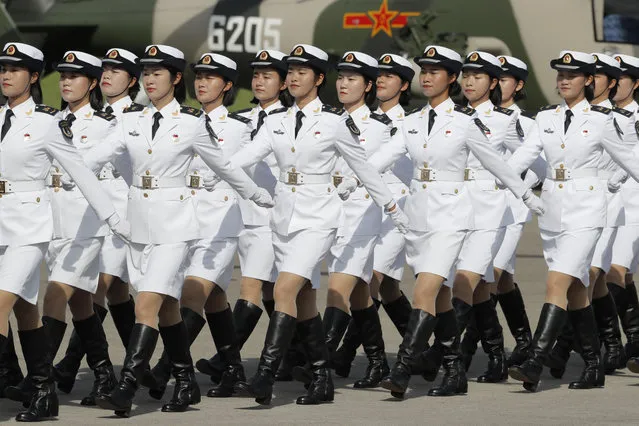
Chinese soldiers march as Chinese President Xi Jinping inspects the troops of People's Liberation Army (PLA) Hong Kong Garrison at the Shek Kong Barracks in Hong Kong, Friday, June 30, 2017. Xi inspected troops based in Hong Kong on Friday as he asserts Chinese authority over the former British colony China took control of 20 years ago. (Photo by Kin Cheung/AP Photo)
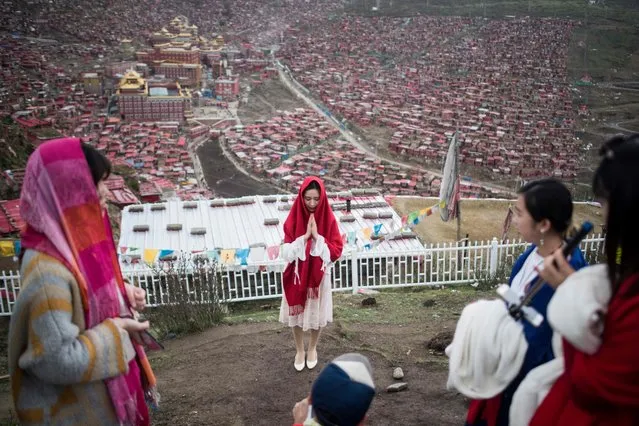
This picture taken on May 29, 2017 shows Chinese tourists posing for a picture overlooking partially demolished houses at the Larung Gar Buddhist Institute in Sertar county in southwest China's Sichuan province. Thousands of monks, nuns and laypeople – including many Han Chinese devotees – crowd this remote valley in Sichuan province to study at Larung Gar, the world's largest and most important institution for Tibetan Buddhist learning. But authorities have ordered the mass expulsion of devotees back to their place of origin, warning that the area is dangerously overcrowded. (Photo by Johannes Eisele/AFP Photo)
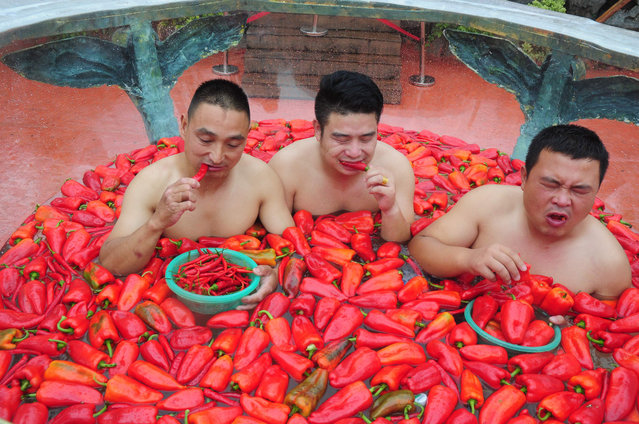
This photo taken on August 12, 2017 shows competitors eating chili peppers while taking a “chili bath” during a chili pepper eating competition in Ningxiang in central China' s Hunan province The winner of the contest, held in the scenic region to attract tourists to Hunan province which is famous for spicy food, was the person who could eat 15 chili peppers in one minute. (Photo by AFP Photo/Stringer)
30 Aug 2017 07:14:00,
post received
0 comments
